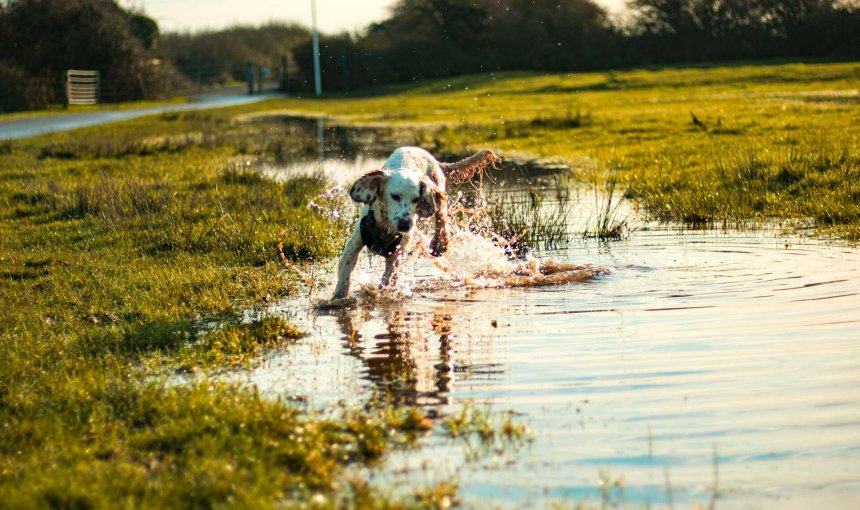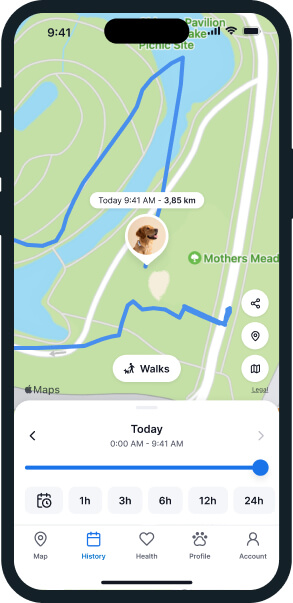 Approved by Dr. Dwight Alleyne, DVM
Approved by Dr. Dwight Alleyne, DVM 6 Tips to Make Your Dog Smell (A Lot) Better
Nobody likes an embarrassing dog smell. But besides just marching them off to the bath, there's a lot you can do to get them smelling like home again. Let's start with these 6 tips.

Ever come home to find that irresistable musky odor – aka, that wet dog smell? Yeah, we’ve been there too. As it turns out, bad breath, poor hygiene, smelly dog farts and other factors come into play. So if you want to find out the reason why your dog stinks, you’ve come to the right place! In this post, we’re also going to cover some tips to get your dog to smell better – including how tracking your dog’s location can actually help you prevent them from exploring somewhere “smelly” nearby. (And bringing it home along with them.) Let’s find out how.

Always know your buddy is healthy & safe
Read moreWhy do dogs smell – why does my dog stink?!
Like us, dogs naturally have their own smell which is perfectly normal. But if their odor becomes abnormally strong or fishy – it’s a good idea to find the cause of the bad dog smell before choosing a treatment. Here are a couple of reasons behind a smelly dog – and why they tend to occur.
- Poor grooming
Common among senior dogs, mobility-affecting health conditions like arthritis might make it difficult for them to groom themselves as well as before. As oils, dander, and dirt build up, your once-fragrant pup might turn into a foul-smelling one instead. - Ear infection
Especially if your dog has a strong smell coming from their ears and/or if you notice any redness or swelling. - Wet dog
A dog’s skin is filled with glands which excrete liquids. Those are meant to protect the dog’s skin. The composition of these liquids is often the reason why your dog smells. As the fur gets wet, more particles are spilled out and the unpleasant smell increases. - Dental disease
Plaque buildup, tartar, decomposing food, or even oral tumors can cause bad breath in dogs. - Gas
Aka, dog farts, a sign that your dog has eaten something that’s difficult to digest, a food allergy or even bowel disease. - Atopy or allergies
Atopy is a skin condition caused by environmental allergies and can lead to other issues – including odor in dogs.
But besides these, here’s a big reason underlying why dogs smell. It’s gotta do with…
Your dog’s adventures outdoors
When your dog goes outside, they’re exposed to all the (possibly smelly) things out there (like skunks). Plus, many dogs love to roll around in mud, dirty water, or even other dogs’ poo! So yes, this could be one reason why your dog stinks. But when you monitor where your dog’s off wandering, you can better intervene if you spot them heading off somewhere they’re likely to pick up the stinkies. (Like your neighbor’s freshly-fertilized farm or a manure heap nearby.)
💡It’s why dog parents around the world – just like you – are using dog GPS trackers as an emergency measure. So you can prevent them from running off and picking up something smelly. (And potentially infectious!)

Follow your dog anywhere
Get real-time location information, wherever they go. And find out when they try to make an escape, or just when they go somewhere they shouldn’t, with Virtual Fences.
6 ways to make your dog smell better – both with & without a bath!
1. Feed your dog a high-quality diet
Diet is an important factor that affects your dog’s smell. Avoid feeding them low-quality food that includes additives, grain content, preservatives, or artificial flavors. Rather, switch to dog food brands higher in meat content. (Along with muscle and organ meats.) Besides, supplements like probiotics can also help their digestion – and also improve their smell.
Dogs can also safely eat a number of fruits and vegetables. Fresh herbs like parsley will also help neutralize your dog’s smell.
2. Keep up with your dog’s grooming routine
Dogs groom themselves, but that doesn’t need to mean they don’t need your help. With a home-friendly dog grooming routine, you can help your dog stay clean (and healthy):
- Brush your dog’s coat regularly to prevent unpleasant odors and manage shedding.
- Gently rinse your dog’s coat and feet after they get dirty from playing outside.
- Bathe your dog as needed (talk to your vet for recommendations).
- Gently remove dirt and crust from around your dog’s eyes with a soft damp cloth any time you notice it.
- Wipe the fold and flaps of dog ears with a clean damp cloth every few weeks.
- Trim the coat, and hair between your dog’s paw pads, as needed.
- Clip dog nails regularly and take good care of paws.
- Add a bit of baking soda to your dog’s bathtime. It can help neutralize bad smells.
3. Wash bedding regularly
No matter where your dog sleeps, make sure to clean their bedding regularly to avoid odor. Dirt, bacteria, dust mites, skin cells, hair, environmental debris, and even parasites can accumulate in a dirty dog bed. So wash your canine friend’s bedding often, just as you should wash your own bed sheets.
⚠️ According to the Cleveland Clinic, dogs can bring fungal organisms into bed with you – like the kind that causes scabies – another reason to wash bedding often!2
4. Don’t forget to brush your dog’s teeth!
Brushing your dog’s teeth regularly is another way to avoid an unpleasant dog smell. It will prevent the buildup of plaque and tartar, not to mention gingivitis and gum disease. You can simply use water to brush your dog’s teeth or a special dog toothpaste.
Read more: Dog Dental Care: How To Get Your Dog The Best Smile Ever
5. Checkup at the vet
Sometimes, a smelly odor in dogs is caused by an underlying health condition that may need treatment. For example, your dog’s bad breath might not just a result of poor dental hygiene. Rather, it might also arise from conditions like diabetes or kidney disease. So if your dog really stinks, it’s a wise idea to bring your dog to the vet for a full check-up.
Tell your vet about the bad dog smell you experience and they will likely be able to tell you the reason, run further tests, and provide recommendations, treatment, or medication if necessary. If your dog does have a health issue which is making them smell bad, early detection and treatment are key to a long and healthy life together!
6. Figure out if your dog’s hanging out somewhere “smelly”
Much like cats, dogs also tend to have their favorite places to spend most of their time. Whether that’s a nearby patch of woodland full of muddy paths or a neighborhood park with a pool they like to splash around in. (Many of which can end up with them returning home soaked and smelly.)
Which is where a dog GPS tracker can help you figure out these spots. Strapped to your buddy’s collar, your Tractive GPS monitors where your dog is off wandering throughout the day, logging in these spots in their Heat Map and Location History:

So you can figure out with just a glance at your phone, where your dog likes to hunt, hide, or just hang out – no matter how far they’re off roaming.
One of your dog’s favorite spots may just be a potentially “smelly” area. Which you’re now better prepared to prevent them from venturing into.
How to get your dog to smell better – bath or no bath
Got a smelly dog at home and not sure what’s causing it? Here are a couple of tips to get your buddy smelling like home again:
- Monitor your dog’s diet
A high-quality diet of meat-based dog foods and dog-friendly fruits and vegetables can help improve any bad breath. - Stay on top of your dog’s grooming
Make sure to brush their coats regularly and also clean around their eyes, ears, and nails. - Wash your dog’s bedding regularly
Often, a weird dog smell can occur from the buildup of dirt, oils, and dander on their bedsheets. - Make dog dental care a priority
Dental diseases don’t just make your dog smell bad – rather, these bacterial infections can potentially lead to fatal diseases over time, if left untreated. - Don’t skip out on your vet visits
Your local vet can run a proper checkup for your dog and help you understand the best treatment. - Figure out your dog’s favorite hangout spots
With Tractive’s Heat Map and Location History, you can understand where your dog likes to spend most of their time. (Including potentially smelly areas.)
Your furry friend’s health and wellbeing means as much as to us as it does to you. So we’ve made it a priority to only share medically-relevant content on our blog. This post was checked, double-checked, and medically verified by Georgia-based vet, Dr. Dwight Alleyne.

Dr. Dwight Alleyne, DVM
Originally from Long Island, New York, Dr. Alleyne began his career at a no-kill animal shelter before becoming a licensed veterinary technician. He graduated from Cornell University Veterinary College in 2006 and completed an internship at Purdue University. Now practicing in Georgia, Dr. Alleyne specializes in soft tissue surgery and ultrasounds. He also writes pet health articles on his website, “The Animal Doctor Blog” (www.anmldrblog.com).



